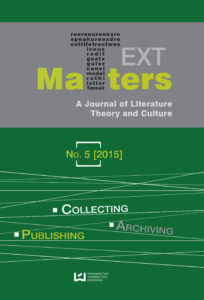“You Avenge the Others”: The Portrait of a Femme Fatale in Gladys Huntington’s Madame Solario
DOI:
https://doi.org/10.1515/texmat-2015-0009Abstract
The article deals with the concept of femme fatale as presented in Gladys Huntington’s 1956 novel Madame Solario. The eponymous protagonist, Natalia Solario, displays several characteristics of this female archetype, omnipresent in literature, culture and visual iconography. As a femme fatale, Natalia is beauty, danger and mystery incarnate. The cause of tragedies, but also a tragic figure herself, Madame Solario is both victim and victimizer. The article explores the interplay between innocence and experience, life and death, the erotic and the thanatic, as well as the motifs of transgression, ambiguity, love, passion, desire, perversion, dominance and control crucial to Huntington’s novel. Madame Solario reminds us that, paradoxically, the femme fatale usurps certain stereotypically masculine traits. This, in turn, brings us to the novel’s feminist dimension: the femme fatale is victimized by men, but she is also the agent of female revenge and, ultimately, liberation, symbolically marking the transition from patriarchy to women’s emancipation.
Downloads
References
“Femme fatale.” Merriam-Webster Online Dictionary. Merriam-Webster. Web. 8 Nov. 2014.
Google Scholar
“Femme Fatale.” Webster’s New World Dictionary. Ed. Victoria Neufeldt. 1989. Print.
Google Scholar
Hart, Josephine. Damage. New York: Random House, 1996. Print.
Google Scholar
Huntington, Gladys. Madame Solario. Surrey: The Book Society, 1956. Print.
Google Scholar
Markus, Ruth. “Femme Fatale at the Turn of the 20th Century.” Femme Fatale. Tel-Aviv: Museum Tel-Aviv, 2006. 179-88. en.ruthmarkus.com. Web. 8 Nov. 2014.
Google Scholar
Minor, Nata. Qui a écrit Madame Solario? Paris: Éditions Métailié, 1992. Print.
Google Scholar
Piechucka, Alicja. “‘Saint Brother and Saint Sister’: The Motif of Fraternal Incest in Gladys Huntington’s Madame Solario.” Polish Journal for American Studies 7 (2013): 65-81. Print.
Google Scholar
Sacher-Masoch, Leopold Ritter von. Venus in Furs. Project Gutenberg. 1 Nov. 2004. Web. 8 Nov. 2014.
Google Scholar
Downloads
Published
How to Cite
Issue
Section
License

This work is licensed under a Creative Commons Attribution-NonCommercial-NoDerivatives 4.0 International License.













